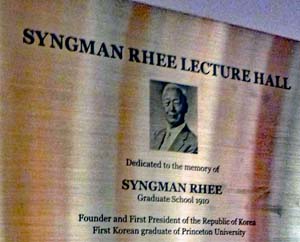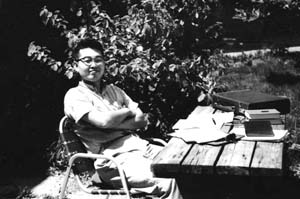Y. S. Kim's Princeton Page

|
- Wherever I go, I brag about my Princeton background. Thus, people ask
me the following questions.
- Am I the first Korean to receive a PhD degree from Princeton?
- Did I meet Einstein and talk to him?
The answer is No to both questions, but I have a story to tell.
- Syngman Rhee received his degree in
1910, and he is known as Woodrow Wilson's most accomplished student. He was
the first and founding president of the Republic of Korea (South Korea). He
was a dictator, but is regarded as the father of democracy in Korea modeled after
American democracy.
- When I went to Princeton as a first-year graduate student in 1958, Einstein
was already in heaven. How can you talk to a person in heaven?
Do you know how Moses talked to God? He wrote five books about God,
They are the first five books of the Old Testament.
- The best way to talk to Einstein is to write a book or books addressing the issues
in which Einstein was most interest. Einstein received his Nobel prize in
1921, but
which is regarded as one of the most important formulas for our civilization.
Thus, the best way to talk to Einstein is to tell him what happened to this
formula since his time.
- Eugene Paul Wigner was regarded as the No. 2 man (after Einstein). He received
his Nobel prize in 1963, but
on his little groups dictating the internal space-time symmetries of particles
in Einstein's Lorentz-covariant world.
In 1986, I told Professor Wigner that his 1939 paper deserved one full Nobel prize
as Einstein's E = mc2 does, by showing the following table.
Contents of Einstein's E = mc2
|
Particle |
Massive/Slow |
between |
Massless/Fast |
|
| Einstein |
Energy
Momentum |
E = p2/2m |
E =
[m2c4 + (cp)2]1/2 |
E = cp |
|
| Wigner |
Helicity
spin, Gauge |
S3
S1
S2
|
Winner's
Little Groups |
Helicity Gauge Trans.
|
|
- This table forces us to go back to the century-old problem. One hundred years ago,
Niels Bohr was worrying about discrete energy levels of the hydrogen atom. Einstein
was interested in how things look to moving observers. Bohr and Einstein met occasionally
to talk about physics. Did they ever talk about moving hydrogen atoms. The answer
seems to be No. Thus, there are two distinct routes to take.
- Since they did not ask this problem, we should resolve this issue.
- Since they did not address this issue, the problem does not exist. It is foolish
to waste time on the problem that does not exist.
Which route would you take? Click here for an interesting story.
Another story.
|
|
Richard Philips Feynman (1919-1988)
- Richard Feynman
was the most creative American physicist in the 20th Century. He received
his PhD degree in 1942. His thesis advisor was John A. Wheeler.
- In 1966, I received a death
sentence (ordering me to stop doing physics) from the physics community for
publishing a paper not consistent with Princeton's view. I survived only
because Feynman in 1970 expressed his view consistent with mine. From there,
I regained my courage.
Feynman was my Savior.
- It is fun to talk about
Feynman.
I maintain my own Feynman site. Feynman was a very colorful person.
You will also be interested in the following pages.
- Artist. Feynman was an artist. He used
to draw pictures when he was doing physics. This resulted in Feynman diagrams.
- Rio de Janeiro. Feynman used to
there very often to join Brazil's Samba artists.
- According to
Feynman, the adventure of our science of physics is a perpetual
attempt to recognize that the different aspects of nature are really
different aspects of the same thing.
- Feynman published approximately 150 papers. Thus it is fun to see whether
those papers can be combined into one. I could not do this, but I was
able to combine three of them into one.
Click here for a story.
- Eugene Wigner also published many papers.
In 1939, Wigner published his paper on internal space time symmetries
of elementary particles. In 1953 with Inonu,
he published a paper on group contractions. It is fun to combine those into
one paper.
- Paul A. M. Dirac was another great physicist of the past century. He was a
beautiful writer, and his papers are like poems. However, his paper does not
contain any figures or illustrations. On the other hand, Feynman was a cartoonist.
He drew pictures and diagrams to express his ideas. Thus, it is fun to translate
Dirac's poems into cartoons.
- I published about 200 papers. According to Feynman's definition of physics,
I should be able to combine all those into one paper. This is not an easy job.
Click here for a story.
|
|

|
while preparing a paper for publication (1961). I did not have
a PC at that time.
Einstein's house in Princeton
|

|
My Einstein page.
|
|
- More about Princeton
- Princeton campus, but an isolated place, one-hour train ride
from New York.
- New York City. I used to go
to New York very often when I was in Princeton (1958-62).
- Parades of Princeton alumni. Lifestyle of affluent Americans.
- Princeton stories. I like to tell you stories.
- Digital Literature. I learned how
to construct webpages during my Princeton years (1958-62). At that time, the concept
of internet was far beyond human imagination. How was this possible?
- Click here for my home page.
- My style page, and
travel page.
- Washington, DC. I
received my PhD degree from Princeton in 1961 and became in 1962 an assistant
professor at the University of Maryland near Washigton, DC. This was the best decision
I made in my life.
| |